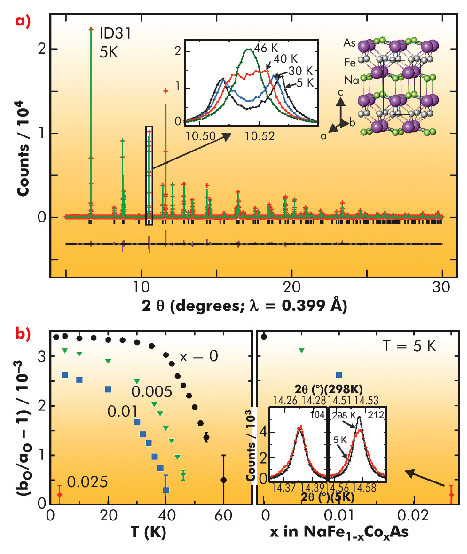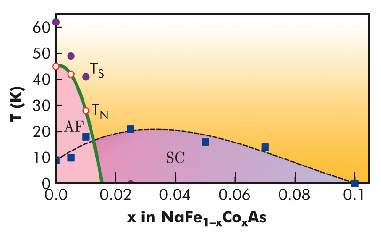- Home
- Users & Science
- Scientific Documentation
- ESRF Highlights
- ESRF Highlights 2010
- Structure of materials
- Suppression of antiferromagnetic order and emergence of superconductivity in Co- and Ni-doped NaFeAs
Suppression of antiferromagnetic order and emergence of superconductivity in Co- and Ni-doped NaFeAs
The emergence of iron-based high temperature superconductors [1] with maximum values of the superconducting transition temperature, Tc, exceeding 50 K, has resulted in the discovery of many new superconductors. These have the common feature of FeAs, FeP or FeSe anti-PbO-type layers separated by electropositive cations, or by thicker fluorite-type or perovskite-related oxide layers. A huge experimental and theoretical effort has been devoted to understanding the origin of superconductivity in these apparently-non-BCS superconductors.
NaFeAs with the anti-PbFCl structure type (Figure 50) was synthesised following the discovery of superconductivity in stoichiometric LiFeAs. NaFeAs may be made stoichiometric, and although there have been reports of isostructural materials which are slightly deficient in Na, these have not been well characterised. It is a general feature of many of the iron-based superconductors that, when the compounds are stoichiometric and iron has a formal oxidation state of +2 and the FeAs4 tetrahedra are fairly close to regular (e.g. NaFeAs, BaFe2As2, LaFeAsO), the compounds are itinerant antiferromagnets in which magnetic ordering at TN drives a structural distortion at TS (where TS ≥ TN). When these compounds are doped either on the iron site, or on the sites in the intervening layers, or when a hydrostatic pressure is applied, the magnetic ground state is suppressed and superconductivity emerges. The exceptions are some of the phosphides and LiFeAs and FeSe which have superconducting ground states when stoichiometric [2].
The ordered moment in NaFeAs is extremely small (~0.1 – 0.3 µB per Fe) so the magnetically ordered state is more amenable to investigation using muon-spin rotation spectroscopy (µSR) than neutron powder diffraction. Furthermore the size of the structural distortion, which is driven by the magnetic ordering, scales with the size of the ordered moment per Fe atom, so quantitative analysis of the small tetragonal-to-orthorhombic distortion in NaFeAs requires high resolution such as that available on ID31.
 |
|
Fig. 50: a) Refinement of the structure of NaFe0.995Co0.005As against ID31 data at 5 K. The thermal evolution of the splitting of the tetragonal 112 reflection into the orthorhombic 022/202 is shown. b) The evolution of the distortion is shown for several compositions. For x = 0.025, which lies well into the superconducting (SC) region, there is no resolvable orthorhombic distortion, although slight broadening of the tetragonal 212 reflection is evident on cooling from 298 K to 5 K. aO and bO are the orthorhombic lattice parameters. |
Zero-field µSR measurements to probe magnetic order were made on the GPS beamline at the Swiss Muon Source. Stoichiometric NaFeAs shows clear oscillations in the muon decay asymmetry characteristic of magnetic ordering with a Neél temperature of 45.0(2) K. Doping with small amounts of Co on the Fe site in NaFeAs has a dramatic effect on the magnetic ordering – the oscillations are heavily damped even at a doping level of 0.5% Co and the Neél temperature decreases rapidly with increasing doping. The antiferromagnetic ordering in these iron compounds results in an orthorhombic distortion of the structure on cooling and we probed this in NaFeAs using the high-resolution neutron powder diffractometer HRPD at the ISIS facility and used ID31 to probe the distortion and its temperature evolution in the cobalt-doped materials. Figure 50 shows the Rietveld refinement against ID31 data of the sample NaFe0.995Co0.005As and the inset shows the evolution of the splitting of the tetragonal 112 reflection as the system distorts from tetragonal P4/nmm to orthorhombic Cmma with a √2aT x √2aT x cT expansion of the tetragonal cell. The suppression of the antiferromagnetic ordering is accompanied by a decrease in the size of the structural distortion and in the temperature at which the distortion becomes evident in the powder diffraction data. By the time sufficient doping has been carried out (~2.5% Co) to drive the system well into the superconducting regime (Figure 51) the distortion is no longer evident even at the high resolution available on ID31.
 |
|
Fig. 51: Phase diagram for Co-doped NaFeAs. The magnetic ordering temperatures (TN) in the antiferromagnetic (AF) region were determined from muon spin rotation experiments. The structural distortion temperatures were determined from the measurements on ID31. |
Further experiments will probe the mixed region between about 1% and 2% Co doping where magnetic order and superconductivity coexist in order to help determine the interplay between magnetism and superconductivity in these compounds.
Principal publication and authors
D.R. Parker (a), M.J.P. Smith (a), T. Lancaster (b), A.J. Steele (b), I. Franke (b), P.J. Baker (c), F.L. Pratt (c), M.J. Pitcher (a), S.J. Blundell (b) and S.J. Clarke (a), Phys. Rev. Lett. 104, 057007 (2010).
(a) Department of Chemistry, University of Oxford (UK)
(b) Department of Physics, University of Oxford (UK)
(c) ISIS Facility, STFC-Rutherford Appleton Laboratory (UK)
References
[1] Y. Kamihara, T. Watanabe, M. Hirano and H. Hosono, J. Am. Chem. Soc. 130, 3296 (2008).
[2] M.J. Pitcher, T. Lancaster, J.D. Wright, I. Franke, A.J. Steele, P.J. Baker, F.L. Pratt, W. Trevelyan Thomas, D.R. Parker, S.J. Blundell and S.J. Clarke, J. Am. Chem. Soc. 132, 10467 (2010).



